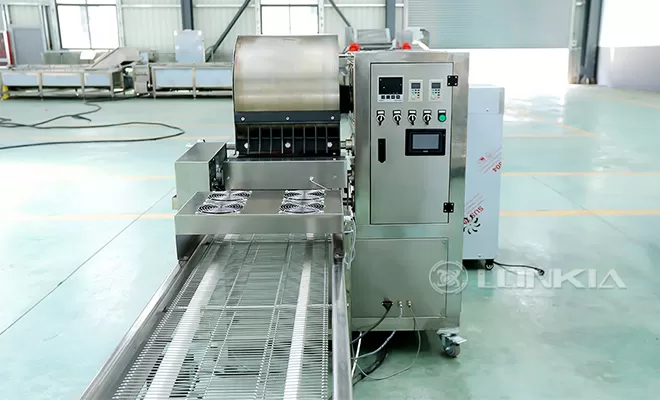Spring roll production in a factory setting involves a streamlined, high-efficiency process to create consistently flavorful and visually appealing spring rolls. From preparing the filling to packaging the finished product, each step is carefully controlled to ensure quality and safety. Here’s a detailed look at the production process for spring rolls in a factory.

1. Preparation of Ingredients
The process starts by selecting high-quality ingredients for the filling, typically including vegetables (cabbage, carrots, and bean sprouts), meats (such as pork or chicken), and seasonings (garlic, soy sauce, and spices).
Vegetables are thoroughly washed, and meats are carefully inspected to ensure safety and quality. Ingredients are cut into uniform pieces to ensure even cooking and blending of flavors.
2. Cooking and Mixing the Filling
The prepared ingredients are then partially cooked, as this helps release flavors and ensures the filling is safe. Cooking can involve stir-frying or steaming, depending on the type of filling and the desired texture.
The cooked ingredients are mixed to create a consistent filling. This step ensures that flavors are well-distributed, and each spring roll contains an ideal mix of ingredients.
3. Cooling the Filling
The cooked filling mixture is quickly cooled to stop the cooking process, which preserves texture and flavor. Rapid cooling is essential to prevent bacterial growth and maintain food safety.
This cooling step also prepares the filling for the wrapping stage, as it prevents the wrapper from becoming soggy or tearing during assembly.
4. Preparation of Wrappers
Spring roll wrappers are prepared using a simple batter made of flour, water, and sometimes a bit of salt. The batter is spread on a heated surface and cooked to form thin, flexible sheets.
In a large-scale factory setting, automated equipment produces uniform wrappers at high speeds, ensuring consistency and reducing labor costs.
5. Filling and Rolling
Once the wrappers are ready, the filling is added to each wrapper. Automated filling machines help ensure that each roll contains the right amount of filling, resulting in consistent weight and size.
The wrappers are then carefully folded and rolled to encase the filling securely. High-speed rolling machines help maintain a tight, uniform roll that is less likely to break during frying or freezing.

6. Frying or Par-Frying (Optional)
Some spring rolls are fried or partially fried before packaging. This step gives them a crispy exterior and helps retain texture and flavor during freezing and reheating.
If fried, the rolls are cooked in oil at controlled temperatures to achieve a golden-brown color. After frying, the spring rolls are drained to remove excess oil and retain crispness.
7. Freezing and Packaging
The spring rolls are then quickly frozen to lock in freshness and extend shelf life. Blast freezing ensures rapid and even freezing, preventing the formation of ice crystals that can impact texture.
Once frozen, the spring rolls are packaged using vacuum-sealed or modified-atmosphere packaging (MAP). This type of packaging maintains product quality by preventing freezer burn and protecting the rolls from contamination.
8. Quality Control and Distribution
Throughout each stage, quality control checks are conducted to monitor taste, texture, and safety. Samples from each batch are inspected to ensure that the spring rolls meet production standards.
The packaged spring rolls are then stored in frozen conditions until distribution. From the factory, they are shipped to retailers, restaurants, or directly to consumers.
Spring roll production in a factory setting combines traditional methods with modern technology to produce high-quality, consistent products on a large scale. At LONKIA, we offer advanced machinery for every step of spring roll production, including filling, rolling, frying, and packaging, to help manufacturers achieve efficient, cost-effective production without sacrificing quality.
